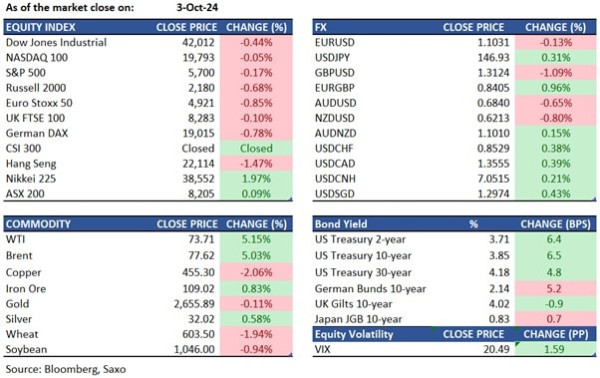Global Market Quick Take: Asia – October 4, 2024
Key points:
- Equities: S&P 500 fell 0.2% after ISM services massive beat
- FX: British pound plunged on BOE Governor’s dovish comments
- Commodities: WTI crude oil surges 5%, marking highest increase in nearly a year
- Fixed income: 10 year yield rises to highest since early September
- Economic data: US NFP
------------------------------------------------------------------
The Saxo Quick Take is a short, distilled opinion on financial markets with references to key news and events.

Disclaimer: Past performance does not indicate future performance.
In the news:
- Stock market today: S&P 500 slips on rising Mid-East tensions; jobs report looms (Investing)
- US port workers and operators reach deal to end East Coast strike immediately (Investing)
- China stimulus draws investors back to offshore bonds of troubled property sector (Investing)
- Oil jumps over $3 a barrel as Middle East conflict stokes supply worry (Reuters)
Macro:
- US ISM Services PMI saw a massive beat, as the headline soared to 54.9 from 51.5, above all analyst forecasts, and was led by a surge in New Orders and Business Activity, to 59.4 (prev. 53.0) and 59.9 (prev. 53.3), respectively. However, the inflationary gauge of Prices Paid lifted to 59.4 from 57.3, and the Employment component slipped into contractionary territory. Inventory sentiment dipped.
- Initial Jobless Claims rose to 225k from 219k, above the 220k forecast, while continued claims for the preceding week were little changed at 1.826mln, beneath the 1.832mln consensus. The 4wk average of initial claims fell to 224.25k from 225k, while the unadjusted numbers totalled 181k, down from the prior 182k. NFP preview: US jobs data is always key to track, but even more so now as the Fed has shifted its focus to labour market with cyclical disinflation giving them some comfort. Consensus expects headline payrolls growth of 150k from 142k in August with unemployment rate steady at 4.2%. Leading indicators for the payrolls have been mixed, with employment sub-index of ISM PMIs leaning weaker while JOLTS jobs openings and August ADP survey data have been higher. Good data can be bad data for the markets, as there has already been some pushback to easing expectations priced in by markets from Chair Powell this week and markets may have to adjust hawkish further. Weaker data, however, will increase the odds of a 50bps rate cut at the November Fed meeting. Market is still split with 35bps of easing priced in.
Macro events: US Jobs Report (Sep), Mainland China market holidays
Earnings: Apogee,
Equities: All three major US indexes ended in the red on Thursday as investors grew concerned about escalating Middle East tensions ahead of the September payroll report. The S&P 500 fell by 0.2%, the Dow Jones dropped 185 points, and the Nasdaq 100 finished almost flat. Market sentiment turned negative after President Biden suggested support for Israel striking Iran’s oil facilities, raising fears of disruptions to global energy supplies. Oil prices surged over 5% on the back of those comments, boosting energy stocks with Valero Energy Corp rising 6% and Occidental Petroleum gaining 2.5%. On the US data front, ISM services data showed expansion in September, beating estimates comfortably just before the NFP data tonight. Earnings include Levi Strauss’ (-7.6%) due to revenue forecast miss and Tesla (-3.3%) halting orders for its cheapest Model 3.
Fixed income: Treasuries fell, pushing yields to their highest levels since early September. This was driven by a stronger-than-expected ISM services index and a surge in crude oil prices due to Middle East supply risks. Both the US 10-year and 30-year yields were set to close above their 50-day moving averages for the first time in at least two months. Yields rose by 5 to 7 basis points across various maturities, with the 5-year maturity seeing the largest losses, flattening the 5s30s curve by about 2 basis points. The 10-year yield was around 3.85%, over 6 basis points higher, compared to its 50-day moving average of about 3.83%. Meanwhile, investors funneled $38.7 billion into US money-market funds, pushing total assets to a record $6.46 trillion, marking the largest quarterly inflow since the March 2023 banking crisis.
Commodities: Oil prices continued to climb, following their largest single-day surge in nearly a year, amid concerns that Israel might retaliate against Iranian crude facilities after a missile barrage earlier this week. West Texas Intermediate (WTI) rose toward $74 a barrel after jumping more than 5% on Thursday, while Brent settled near $78. Oil is on track for its biggest weekly gain since March 2023. Gold remained steady ahead of a jobs report that could provide insights into the health of the US economy, as markets considered the potential for further monetary easing by the Federal Reserve. After three consecutive weekly gains, including a record high for bullion in late September, the precious metal was set to end the week relatively unchanged. Meanwhile, copper gave back some of its recent gains driven by China’s stimulus measures, with better-than-expected US jobs data also contributing to the decline.
FX: The US dollar extended its gains further with the ISM services data coming in much stronger than expected, and lingering geopolitical risks also underpinning. The British pound underperformed, after the dovish comments from BoE Governor Bailey. He said the bank could be a "bit more aggressive" in cutting rates provided the news that inflation continues to be good. Other cyclical currencies like kiwi dollar and Aussie dollar were also down, with 0.8% and 0.65% respectively, as momentum in Chinese stocks listed in HK started to deflate with onshore China markets on holiday and questions around whether current stimulus measures could prove enough to address the structural headwinds. The euro was the most resilient, while Japanese yen and Swiss franc were down modestly.
For all macro, earnings, and dividend events check Saxo’s calendar.
For a global look at markets – go to Inspiration.